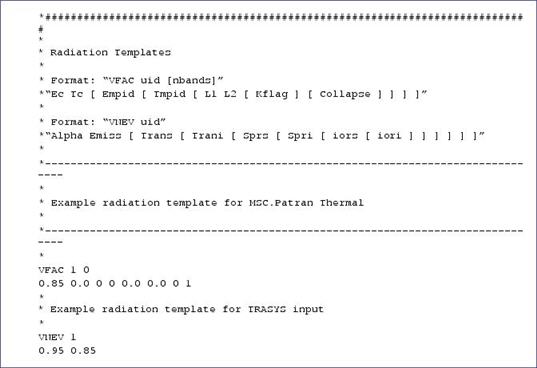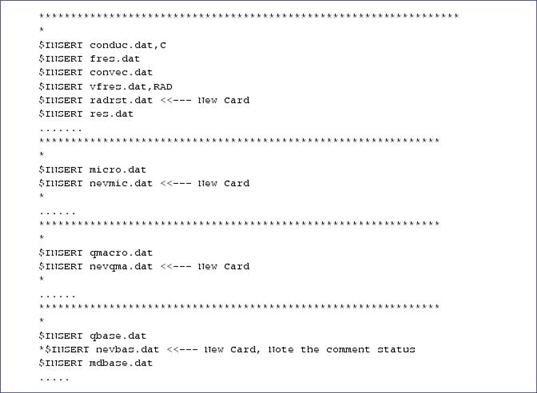XXXXXXXXXXXXXXXXXXXXXXXXXXXXXXXXXXXXXXXXXXXXXXXXXXXXXXXXXXXXXXXXXXXXXXXXXXXXXXXXXXXXXXXXXXXXXXXXXXXXXXXXXXXXXXXXXXXXXXXXXXXXXXXXXXXXXXXXXXXXXXXXXXXXXXXX''"> Using NEVADA Translator
Translation of Patran Thermal View Factors to NEVADA
Patran Thermal problems that define view factor calculations can be translated for input to and from the NEVADA code. The correspondence between the Viewfactor code subelemental areas and the NEVADA surface is shown in Figure C-9. A restricted subset of both Patran Thermal and NEVADA capabilities are supported at the moment. The linkages between the codes are not automatic and require intervention by the users in executing the calculations in either direction. Patran Thermal 1.4-2 or later is required to do the translation. The translation requires the vfin.dat file created during the Patran Thermal submit. The basic procedure is outlined in the following sections.
Figure C‑8 Mapping between the Viewfactor code subelemental areas and the NEVADA Surface Nodes.
Translating Patran Thermal Model to NEVADA Input
Some of the steps below assume that Patran version 1.4-2 or later is available. For example, if the template.dat.apnd file is defined before the job is spawned from Patran, the template file will be pulled into the directory where the job is expected to execute. There is more than one way that a user can build the NEVADA results; the following outlines one method.
First the template file has a new entry that defines the NEVADA surface properties. This entry is defined below:
In the above example the different item in the VFAC template which is used by Patran Thermal are:
VFAC | Key word denoting P/Viewfactor information |
uid | User defined template ID |
nbands | Number of band for wavelength dependent radiation |
Ec | Constant Surface Emissivity |
Tc | Constant Transmissivity of participating media |
Empid | Material property ID of variable Surface Emissivity |
Tmpid | Material property ID of variable participating media Transmissivity |
L1 | Lower wavelength of multiple band radiation. |
L2 | Upper wavelength of multiple band radiation |
Kflag | Extension Coefficient flag |
Collapse | Collapse flag |
The VNEV defines the surface properties required by NEVADA. The input definitions are:
Alpha | Solar Absorptivity |
Emiss | IR Emissivity |
Trans | Solar Transmissivity |
Trani | IR Transmissivity |
Sprs | Solar Specular Reflectivity |
Spri | IR Specular Reflectivity |
Iors | Solar Index of Refraction |
Iori | IR Index of Refraction |
The forward translation is done by executing PATQ. It assumes that you have already translated the neutral file to generate the required QTRAN input files in a previous step - menu pick 2. This is followed by a menu pick 6 which brings up the additional utilities menu and select menu pick 18 which will read the vfin.dat file and reformat the radiating surfaces into polygons in the NEVADA format. The output file for input to NEVADA is given the name nevada.inp. NEVADA only recognizes one enclosure thus it is import to only include one enclosure in the model being translated. Each radiating surface is given a NEVADA node ID which is 10 times the Patran Thermal surface ID. The parent Patran element ID and node ID’s are identified in comment portions of the NEVADA surface declarations.
Some restrictions on how the NEVADA run should be made are: One, the units for NEVADA are BTU, feet and hours. The thermal model when it is generated in Patran should be in these units. If the model has different geometric units, the conversion should be exercised at the initial translation so that all conduction, convection and radiation boundary conditions are in a consistent set of units. Two, since the radiation resistor/conductors defined for Patran Thermal do not include the Stefan Boltzmann constant, SIGMA should be set to 1.0 for the NEVADA run. If it is desired to make a run with SINDA, then the SIGMA can be defined in the SINDA input. The desired output for the resistor network should be directed to tape and punched output should be requested for the desired solar heat fluxes.
The Patran THERMAL NEVADA reverse translator treats the NEVADA ambient (space) node radk's differently than other surface to surface radk's. In the forward translation to NEVADA from Patran THERMAL, each element surface from Patran THERMAL is multiplied by 10 as it is written to the NEVADA input deck. If the enclosure references an ambient node, then that node ID is added in a comment card at the end of the NEVADA input deck. When creating a space node in Patran for NEVADA translation, a space node ID of 9999 must be used.
NEVADA Output to Patran Thermal Input
After a successful NEVADA run has been made, fixed format ASCII files - one for the heating rates and another for the radiation network - should be present. By examining the data in specific fields, it is possible to determine if heating rates, periodic loading or average orbital heating loads are defined. The reverse translator is initiated by going into the utilities menu and executing option 19. At that point the user will be queried if the nodal quantities are to be formatted for SINDA as well as P/THERMAL. You can select output for each of the three types of output available - average heat flux, periodic heat flux, or radiation resistors. For each selection, you are again queried for input and output file names, plus various index offsets and units conversion factors. For the resistors, an intermediate file - tratpt.dat is created which has all the resistor distributed to a given node before they have been combined.
After the reverse translation has been completed, you will have four files, if all options have been exercised. The Patran Thermal qin.dat file has the default names included as insert records in the proper places. The default file names are:
radrst.dat | The equivalent NEVADA radiation resistor network. Note: You can either use the RADRs from NEVADA or the radiation couplings created by the view factor code or both. |
nevmic.dat | The micro function file which has the equivalent NEVADA periodic array data |
nevqma.dat | The qmacro function file which defines the NEVADA periodic heating to each surface that is distributed to each Patran Thermal node. |
nevbas.dat | The average heating from NEVADA surface that is distributed to each Patran Thermal node. |
Currently, all these files are ascii. Either have the desired input files available or comment out the undesired insert directives, so that only the desired options are loaded in the QTRAN run. For example, both the average heating and periodic heating should not be defined for the same run. Examples of where the new insert directives are located is shown below.



